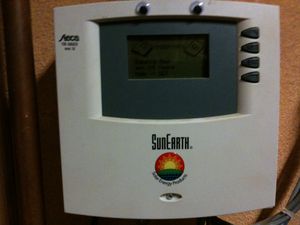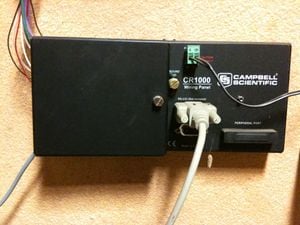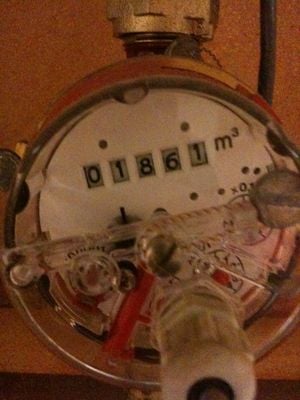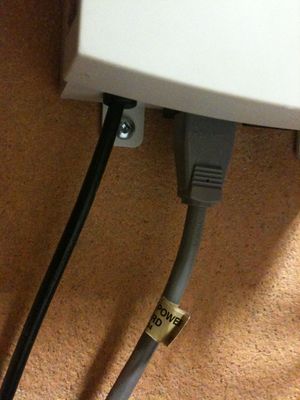
This is the Operation and Maintenance (O&M) manual for CCAT Data Collection. Please refer to it and keep it up to date with any O&M changes.
Also, check out the HEIF CCAT solar hot water system/OM for more information about the solar hot water system.
The CCAT Dataloggers[edit | edit source]
- Click here to see data tables recorded by the SunEarth
- Click here to see data tables recorded by the CR1000
There are two dataloggers currently recording data from the solar thermal system: the SunEarth Aeca TR0603 mc U and the Campbell Scientific CR1000. It is not clear when both systems were added, but there is data from the CR1000 that dates back to 2010.

The original purpose of the dataloggers was to record data from the solar thermal system and figure out a way to publish that data on CCAT's website as a demonstration of the solar thermal resource and its utilization for domestic hot water and radiant heating at CCAT. However, that goal has not been realized due to the limited institutional memory at CCAT and the complexity of the datalogging and publishing process.
In order to gather information related to these devices, the following sources and individuals were consulted:
- The original proposal submitted to the Humboldt Energy Independence Fund (HEIF) in the Fall of 2008 to install the solar thermal system and its associated components. The proposal was submitted by Laura Hughes and Jeff Steuben. Peter Alstone was the consulting engineer from the Schatz Energy Research Center.
- Ben Scurfield of Scurfield Solar also assisted with the installation of the temperature sensors and other devices when the solar thermal system was first installed, and then when it was reinstalled when CCAT was given a new metal roof.
- Dr. Arne Jacobson from the Environmental Resources Engineering Department and the Schatz Energy Research Center assisted with the HEIF proposal and has also used the solar thermal system as a demonstration in the Solar Thermal course.
- Lonny Grafman from the Environmental Resources Engineering Department and the CCAT Steering Committee also assisted with the HEIF proposal and has been working tirelessly to promote the longer life of CCAT projects.
- Roger Tuan has perhaps been the best resource. Roger was a Co-Director at CCAT in 2010. Roger has served in a variety of capacities and has continued to assist with CCAT projects well after his directorship. Roger assisted with connecting to and debugging the CR1000 and was also the source for the data pulled from 2010 and 2011.
- Chris Stone was not consulted directly, but had a hand in the programming of the CR1000.
Although a system is currently being set up to collect and publish the data from the CCAT photovoltaics system through an ENGR305 student (Jenna Bader), a solution for reliably collecting and publishing the data from the CCAT solar thermal system has not been realized. However, recommendations for next steps are included in the suggestions for the future.
The following information has also been learned about the datalogging devices:
- The SunEarth is connected to three temperature sensors and one flow meter. The cables can be followed directly from the base of the SunEarth to their respective destinations:
- The temperature at the outlet of the solar collectors on the roof (recorded in the csv files as T1)
- The temperature at the outlet of the heat exchanger at the base of the Phoenix hot water heater (recorded in the csv files as T2)
- The temperature at approximately one third of the way up the Phoenix water heater (recorded in the csv files as T3). It is possible that this temperature represents the temperature at level of the natural gas furnace heat exchanger, potentially serving as a way to separate out the solar thermal resource versus the natural gas contribution toward hot water in the Phoenix. However this is speculation.
- The flow meter attached to the copper tubing going to the solar collectors on the roof. By inference, it seems that this value is recorded in the csv files as R1, a percentage. Potentially, the percentage represents the time that the pump is turned during the five minute interval over which the SunEarth records data. However, this result is misleading, because it implies that that the pump is operated in an on-off mode with only one speed. However, based on data from the CR1000 (explained below) and visual inspection, it seems that the SunEarth is actually controlling the pump with a differential controller that varies the pump speed according to the differential temperature of the T1 and T2 temperature sensors.
- The SunEarth records the data on an SD card that can be removed from the slot on the right side of the device. The device records data every five minutes and creates a csv file every day. When the SD card was inspected during this report, the data began in September, 2013.
- Based on a conversation with Ben Scofield, it seems that the SunEarth pump controller is set to turn the pump on when T1 is fifteen degrees greater than T2 and turn the pump off when T1 is four degrees greater than T2.
- The CR1000 is a sophisticated (and expensive) device that currently records data related to temperature, solar resource, and flow rate. The leads for the wires connected to the CR1000 disappear into the dropped ceiling of the CCAT basement, so the following is based on inference from the data and from what Roger Tuan remembers from his conversation with the consulting engineer who installed the system:
- The indoor and outdoor air temperature. There is probably a temperature sensor on the roof to record the outdoor air temperature. However, it is not clear where the indoor air temperature sensor is located. Potentially in the basement in order to calculate the heating load through the radiant heating?
- The indoor and outdoor H2O temperatures. It is inferred that H2O in this case means the propylene glycol/water mixture in the solar thermal system. Also, since there are no obvious temperature sensors in the basement where the water supply for the domestic hot water originates, it is inferred that these values actually correspond to the temperature of the working fluid at the inlet and outlet of the solar collectors.
- The solar radiation recorded from a pyranometer located on the roof of CCAT. This value is recorded in Watts per square meter.

- The flow rate from the flow meter on the solar thermal system. This cable is spliced inside the SunEarth so that the pulses from the flow meter are sent to both the SunEarth and the CR1000. However, while the SunEarth apparently fails to record the flow rate (perhaps because the cables are tied into the wrong port on the SunEarth?), the CR1000 does record the number of pulses during the recording interval. Each pulse corresponds to the passage of one deciliter through the flow meter. This can be observed visually by watching the spinning of the flow indicator on the flow meter on the far left (0.0001m3). Since this value varies over the period which the pump is on, it is clear the SunEarth is acting as a differential controller that controls the pump speed instead of simply an on-off switch. Ben Scurfield indicated that this setting may result in premature wear on the pump, as the varying voltage and current sent to the pump is harder on the pump than simply turning on and off. However, it is not clear whether the premature wear-and-tear is balanced out by the more sophisticated control of the working fluid flow.
- The CR1000 is designed to run on 12VDC. As a result, there is a charge controller and back up sealed lead acid battery that are connected to the CR1000. These devices are in working order and should not be disturbed.
Operation[edit | edit source]

Both datalogging devices are designed to run autonomously with little or no operational attention. A person can cycle through the T1 and T2 temperatures on the SunEarth display to confirm that it is on and working. Also, since the SunEarth serves as the pump controller, it is important to make sure that the pump stays plugged into the SunEarth and not into the wall.
Once a reliable procedure is established for collecting and storing the data from both devices, there may be a need to regularly remove the SD card and record the data in a reliable location.
Maintenance[edit | edit source]
The dataloggers are designed to not require much attention for operation or maintenance. However, accessing and modifying the datalogging function is a very complex process. Until a reliable method is developed for harvesting the data, graphically representing it, and publishing it to the web, the dataloggers can continue to record data without being disturbed.
Troubleshooting[edit | edit source]
If it seems that the SunEarth is not on or that the pump is not functioning, make sure that the SunEarth power cord is still plugged into the wall. Otherwise, consult a professional like Ben Scurfield as soon as possible.
Suggestions for future changes[edit | edit source]
In consultation with Roger Tuan, the following represent our recommendations for next steps:
- Ideally, all the data would be recorded by one device so that data does not have to be regularly collected from two different devices (this is particularly true for the SunEarth that generates a csv file for each day, whereas the CR1000 data is already compiled in one file). This can be achieved by splicing the connections currently going into the SunEarth and taking them into the CR1000 (in the same way that the flow meter is currently spliced in the SunEarth).
- Ideally, there would also be a device like a Raspberry Pi that would regularly record the data from the dataloggers and publish it on the internet. If the project currently underway with the PV system is successful, it is possible that Linux based software can be installed on the Raspberry Pi to automatically record and publish the data from the CR1000 in addition to the data being recorded and published from the Aurora inverter.
Unfortunately, the CR1000 has not been recording data for the last four years. Apparently, the data logging program was loaded on the CR1000 but not active. It is imperative that backup copies of this program are made because installing a new program would require knowing all the specifications of the sensors which are currently scattered through CCAT or on CCAT's roof. However, as of the writing of this report, both the SunEarth and the CR1000 are recording data from all the sensors to which they are connected.